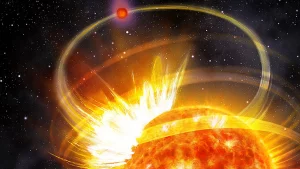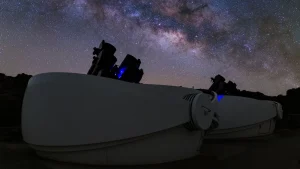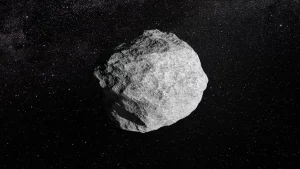Dinosaurs survived one mass extinction, but then their luck ran out

Dinosaur Mysteries digs into the secretive side of the “terrible lizards” and all the questions that keep paleontologists up at night.
WE ALL KNOW about the asteroid. Close to 66 million years ago, during spring in the Northern Hemisphere, a 6-mile-wide chunk of space rock slammed into our planet and set off the world’s fifth mass extinction. Around 75 percent of all existing plant and animal species vanished almost overnight, and our beloved dinosaurs were decimated. Of the dinosaurian herd, only beaked birds made it to modern times.
But we’ve been so focused on how the Age of Dinosaurs ended that their unexpected rise is often overlooked. Around 201 million years ago, at the dawn of the Jurassic Period, a different mass extinction allowed dinosaurs to become the “terrible lizards” we so adore. Of the five mass extinctions that paleontologists recognize, it was the fourth that truly set the stage
The idea of dinosaur “dominance” is so commonplace that it’s strange to think there was a time in the distant past when the reptiles were not large and in charge. Yet that is exactly what paleontologists have discovered. The oldest dinosaurs we presently know of, from Triassic rocks dating to more than 230 million years ago, were relatively small, slender creatures who were rare compared to the other animals of the ancient landscape. The recently named Mbiresaurus raathi from Zimbabwe, for example, was a bipedal herbivorous dinosaur about the size and weight of a German shepherd, far from the largest or most ferocious creature of its time.
The Triassic saw different families of reptiles thrive. A mass extinction at the beginning of the period, caused by massive volcanic outpourings in what’s now Siberia, spurred rapid global warming, changes in atmospheric oxygen levels, and other ecological havoc that pushed the scaly creatures to evolve in new ways or go extinct. The first dinosaurs that evolved in the aftermath were slender, omnivorous creatures about the size of a labradoodle. But the reptiles that left the biggest mark on the landscape were ancient cousins of today’s crocodiles—a group called pseudosuchians.
Over the past two decades, paleontologists have uncovered multiple pseudosuchians that evolved dinosaur-like anatomies and behaviors long before actual dinosaurs did. The boxy-headed carnivore Postosuchus looked so much like a Tyrannosaurus rex that it was initially mistaken for a T. rex ancestor rather than the crocodile it is. The small herbivore Effigia okeefeae ran on two legs and had a beak rather than teeth, resembling “ostrich mimic” dinosaurs like Struthiomimus altus, a species that would evolve over 100 million years later. The thick-plated “armadillodiles” Desmatosuchus were pseudosuchians too, pioneering a spiky style that would later be reinvented by ankylosaurs. Prehistoric crocodiles came in every shape and size in the Triassic, while dinosaurs were mostly small, svelte, and not all that anatomically remarkable. Some were starting to get big by the end of the period, but they were nothing like the marvelous oddballs we saw in the Jurassic.
But by the 1950s, paleontologists noticed that many of the Triassic animal groups they had uncovered had disappeared by the earliest days of the following period, the Jurassic. The vast majority of the diverse pseudosuchians vanished, while dinosaurs seem to persist through the Triassic-Jurassic boundary almost unscathed. Experts have proposed everything from changing sea levels to an earlier asteroid impact to explain the biodiversity shake-up, though the most likely culprit is another intense bout of volcanic belches in the sprawling Central Atlantic Magmatic Province. The eruptions happened when the supercontinent Pangaea was just breaking up, but we can get an idea of the areas affected by looking at preserved volcanic rocks in the jigsaw of today’s continents. Traces of the pulse, which went on for more than half a million years and increased global atmospheric carbon dioxide to levels 10 times higher than what we’re dealing with today, have been found from Nova Scotia to Brazil. And that’s hardly all. Geologists have also found evidence of sulfur dioxide in rocks from this critical time, compounds that would have caused rapid cooling in between warm spells created by greenhouse gases.
Why the protocrocs faded while dinosaurs shrugged off these changes is a mystery. On paper, you’d think that a group of animals that evolved a broader variety of shapes, sizes, and behaviors would fare better under pressure. While some crocs did persist, they were the small, relatively generalized carnivores that chased bugs and lizards rather than the large, intricate ones. Small opportunists tend to fare better through mass extinctions, as they’re able to find enough food and habitat while larger, more specialized animals struggle. But the fact that members of all three main dinosaur groups—the predecessors of the Allosaurus, Apatosaurus, and Stegosaurus genera—all survived seems strange when you consider the fate of their distant crocodilian relatives.
The secret may be found within tissues and biological systems that are more difficult to preserve than bone. In 2020, paleontologists described a close relative of the common ancestor of dinosaurs and the flying pterosaurs—a tiny reptile they named Kongonaphon kely. Such a small animal would have benefitted from its warm, fluffy protofeathers—a trait present in both dinosaurs and pterosaurs—and paleontologists suspect that small size, warm-bloodedness, and an insulating coat were inherited by the first dinosaurs. Those qualities would have allowed them to withstand a greater variety of habitats than their crocodile cousins.
The backstory makes a little more sense in light of new research shared last year. Fossils of early dinosaurs are sometimes found in habitats that would have been frozen for at least some parts of the year. Though prolific, pseudosuchians seem to have been distributed only through warmer areas while Triassic dinosaurs had a greater range, allowing them to persist through the shifting climates created by the incredible eruptions 201 million years ago.
Had those eruptions not occurred or had they been less intense, it’s possible that the “Age of Dinosaurs” might instead have been the “Age of Crocodiles.” Dinosaur evolution would have been shaped by interactions with a broader cast of pseudosuchians, making for an alternative universe we’ll never get to see. A pair of mass extinctions cleared the ecological decks and allowed dinosaurs to venture to places where they could prosper and adapt into new forms—a wistful contrast to their own disastrous moment many millions of years later.
We hope you enjoyed Riley Black’s column, Dinosaur Mysteries. Check back on PopSci+ in September for the next article.








